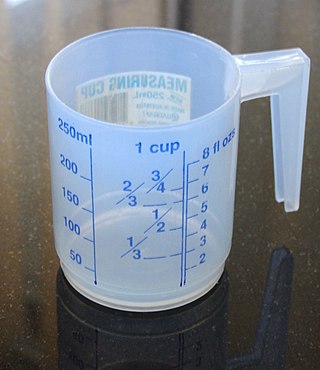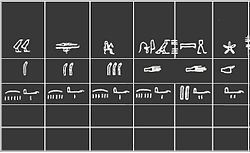
Hipparchus was a Greek astronomer, geographer, and mathematician. He is considered the founder of trigonometry, but is most famous for his incidental discovery of the precession of the equinoxes. Hipparchus was born in Nicaea, Bithynia, and probably died on the island of Rhodes, Greece. He is known to have been a working astronomer between 162 and 127 BC.

Volume is a measure of regions in three-dimensional space. It is often quantified numerically using SI derived units or by various imperial or US customary units. The definition of length (cubed) is interrelated with volume. The volume of a container is generally understood to be the capacity of the container; i.e., the amount of fluid that the container could hold, rather than the amount of space the container itself displaces. By metonymy, the term "volume" sometimes is used to refer to the corresponding region.
Biblical and Talmudic units of measurement were used primarily by ancient Israelites and appear frequently within the Hebrew Bible as well as in later rabbinic writings, such as the Mishnah and Talmud. These units of measurement continue to be used in functions regulating Jewish contemporary life. The specificity of some of the units used and which are encompassed under these systems of measurement have given rise, in some instances, to disputes, owing to the discontinuation of their Hebrew names and their replacement by other names in modern usage.

Nut, also known by various other transcriptions, is the goddess of the sky, stars, cosmos, mothers, astronomy, and the universe in the ancient Egyptian religion. She was seen as a star-covered nude woman arching over the Earth, or as a cow. She was depicted wearing the water-pot sign (nw) that identifies her.

The cubit is an ancient unit of length based on the distance from the elbow to the tip of the middle finger. It was primarily associated with the Sumerians, Egyptians, and Israelites. The term cubit is found in the Bible regarding Noah's Ark, the Ark of the Covenant, the Tabernacle, and Solomon's Temple. The common cubit was divided into 6 palms × 4 fingers = 24 digits. Royal cubits added a palm for 7 palms × 4 fingers = 28 digits. These lengths typically ranged from 44.4 to 52.92 cm, with an ancient Roman cubit being as long as 120 cm.

The foot is a unit of length in the British imperial and United States customary systems of measurement. The prime symbol, ′, is commonly used to represent the foot. In both customary and imperial units, one foot comprises 12 inches, and one yard comprises three feet. Since an international agreement in 1959, the foot is defined as equal to exactly 0.3048 meters.

The hand is a non-SI unit of measurement of length standardized to 4 in (101.6 mm). It is used to measure the height of horses in many English-speaking countries, including Australia, Canada, Ireland, the United Kingdom, and the United States. It was originally based on the breadth of a human hand. The adoption of the international inch in 1959 allowed for a standardized imperial form and a metric conversion. It may be abbreviated to "h" or "hh". Although measurements between whole hands are usually expressed in what appears to be decimal format, the subdivision of the hand is not decimal but is in base 4, so subdivisions after the radix point are in quarters of a hand, which are inches. Thus, 62 inches is fifteen and a half hands, or 15.2 hh.
The pyramid inch is a unit of measure claimed by pyramidologists to have been used in ancient times.
Ancient Egyptian mathematics is the mathematics that was developed and used in Ancient Egypt c. 3000 to c. 300 BCE, from the Old Kingdom of Egypt until roughly the beginning of Hellenistic Egypt. The ancient Egyptians utilized a numeral system for counting and solving written mathematical problems, often involving multiplication and fractions. Evidence for Egyptian mathematics is limited to a scarce amount of surviving sources written on papyrus. From these texts it is known that ancient Egyptians understood concepts of geometry, such as determining the surface area and volume of three-dimensional shapes useful for architectural engineering, and algebra, such as the false position method and quadratic equations.
The megalithic yard is a hypothetical ancient unit of length equal to about 2.72 feet (0.83 m). Some researchers believe it was used in the construction of megalithic structures. The proposal was made by Alexander Thom as a result of his surveys of 600 megalithic sites in England, Scotland, Wales and Brittany. Thom also proposed the megalithic rod of 2.5 megalithic yards, or on average across sites 6.77625 feet. As subunits of these, he further proposed the megalithic inch of 2.073 centimetres (0.816 in), one hundred of which are included in a megalithic rod, and forty of which composed a megalithic yard. Thom applied the statistical lumped variance test of J.R. Broadbent on this quantum and found the results significant, while others have challenged his statistical analysis and suggested that Thom's evidence can be explained in other ways, for instance that the supposed megalithic yard is in fact the average length of a pace.

A finger is any of several units of measurement that are approximately the width of an adult human finger. [Exactly which part of the finger should be used is not defined; the width at the base of fingernail is typically less than that at the knuckle (#6).]

The palm is an obsolete anthropic unit of length, originally based on the width of the human palm and then variously standardized. The same name is also used for a second, rather larger unit based on the length of the human hand.
The ancient Egyptian units of measurement are those used by the dynasties of ancient Egypt prior to its incorporation in the Roman Empire and general adoption of Roman, Greek, and Byzantine units of measurement. The units of length seem to have originally been anthropic, based on various parts of the human body, although these were standardized using cubit rods, strands of rope, and official measures maintained at some temples.
A knotted cord was a primitive surveyor's tool for measuring distances. It is a length of cord with knots at regular intervals. They were eventually replaced by surveyor's chains, which being made of metal were less prone to stretching and thus were more accurate and consistent.

The earliest recorded systems of weights and measures originate in the 3rd or 4th millennium BC. Even the very earliest civilizations needed measurement for purposes of agriculture, construction and trade. Early standard units might only have applied to a single community or small region, with every area developing its own standards for lengths, areas, volumes and masses. Often such systems were closely tied to one field of use, so that volume measures used, for example, for dry grains were unrelated to those for liquids, with neither bearing any particular relationship to units of length used for measuring cloth or land. With development of manufacturing technologies, and the growing importance of trade between communities and ultimately across the Earth, standardized weights and measures became critical. Starting in the 18th century, modernized, simplified and uniform systems of weights and measures were developed, with the fundamental units defined by ever more precise methods in the science of metrology. The discovery and application of electricity was one factor motivating the development of standardized internationally applicable units.

A measuring rod is a tool used to physically measure lengths and survey areas of various sizes. Most measuring rods are round or square sectioned; however, they can also be flat boards. Some have markings at regular intervals. It is likely that the measuring rod was used before the line, chain or steel tapes used in modern measurement.
Some approaches in the branch of historic metrology are highly speculative and can be qualified as pseudoscience.

Egyptian astronomy began in prehistoric times, in the Predynastic Period. In the 5th millennium BCE, the stone circles at Nabta Playa may have made use of astronomical alignments. By the time the historical Dynastic Period began in the 3rd millennium BCE, the 365 day period of the Egyptian calendar was already in use, and the observation of stars was important in determining the annual flooding of the Nile.

Egyptian geometry refers to geometry as it was developed and used in Ancient Egypt. Their geometry was a necessary outgrowth of surveying to preserve the layout and ownership of farmland, which was flooded annually by the Nile river.











